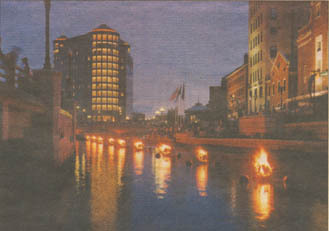
WaterFire Providence has become a major tourist attraction, drawing more than 1.1 million people to Providence in 2004, with a direct economic impact of $33.2 million, according to studies.
It looked like difficult times for Rhode Island’s travel economy when David DePetrillo became the state’s tourism director in 1983.
Providence had just come out of a turbulent decade that saw the closing of its most visible hotel, the Providence Biltmore, for five years (it reopened in 1979). Newport, the state’s driving force for leisure travel, had lost one of its marquee events, the America’s Cup race.
As other industries declined, the state was losing business travelers as well. And tourism, despite its great potential, was an afterthought.
“The industry itself had not been focused on as a key part of economic development,” DePetrillo recalled last week. “It was seen as very seasonal and not as providing the kinds of jobs the state was looking for.”
After DePetrillo took over, the state began developing a strategic plan to expand tourism.
One of the most successful initiatives, he said, was a push to attract foreign visitors. In 1986, Rhode Island was the first state to host a statewide international tourism conference.
“We had an opportunity to say, ‘Hey, this could work,’ ” DePetrillo said. And it did. While 20 years ago Rhode Island had very few foreign visitors – except from Canada – today it sees many travelers from the United Kingdom, Japan, Germany and other countries.
Providence’s renaissance also has helped to attract more people into the city. The massive river relocation project of the late 1980s and early 1990s transformed the downtown area, replacing a large, unsightly stretch into Waterplace Park.
Artist Barnaby Evans’ WaterFire Providence has become a major tourist attraction, drawing more than 1.1 million people to Providence in 2004, with a direct economic impact of $33.2 million, according to studies.
The R.I. Convention Center, planned in the 1980s and opened in 1993, has attracted thousands of visitors to the city for both business and leisure.
Before the convention center opened, DePetrillo said, meetings and conventions were “restricted to single-property hotels and whatever could be held at the civic center.” With the convention center, “we said that would bring a whole new segment of business that we had not been able to go after before,” he said. In addition, the city already had several resources, such as history, architecture and museums that brought people in.
But DePetrillo said no one development or event can be given credit for the emergence of Providence as a tourist destination.
“A lot of things did come together at once,” DePetrillo said. “It was not an overnight renaissance.”
The attractiveness of the city also aided hoteliers who decided to jump into the market. Larger facilities, such as the state-built The Westin Providence, sprouted. But boutique hotels, including Hotel Providence on Westminster Street, also have proven to be successful.
“You can have the most phenomenal product, but if the destination doesn’t have the overall appeal,” it will not attract people, said Suzanne Grogan, director of sales and marketing for Hotel Providence.
The growth of the travel market also spread beyond Providence and Newport.
Warwick, which is host to the state’s only major commercial airport, has experienced a rapid expansion of hotel space, DePetrillo said, adding that its growth is one of the state’s biggest tourism successes of the past two decades.
According to city tourism director Karen Jedson, Warwick has seen a 1,000-room increase in available hotel rooms in the last 10 years, to 2,250. Also, she said, development being planned could add as many as 400 rooms.
Marie Bouchard, director of sales and marketing for the Radisson Airport Hotel Providence on Post Road in Warwick, said she has witnessed a large increase in visitors staying in the city’s hotels.
But with that, there have been some lulls in the business travel economy, she said.
Economic factors such as rising energy costs have increased the cost of operations and cut into some business. In addition, the Sept. 11 terrorist attacks in 2001 had an impact and resulted in increased security.
But overall, despite shifts in the economy, DePetrillo said the state has experienced a boom in tourism. And he credits in large part the state’s willingness to get behind travel and hospitality and consider it an economic driver.
The fact is underscored by last month’s unveiling of the state’s 2006 summer tourism promotion campaign, which highlights the state’s natural resources.
“Tourism continues to be a major economic driver for Rhode Island,” said R.I. Economic Development Corporation Executive Director Michael McMahon. “More than 68,000 Rhode Islanders work in the travel, tourism and hospitality professions. It’s absolutely crucial that we continue to support this growth industry.”











